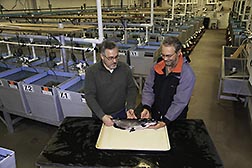| Read the magazine story to find out more |
|
|
|
|
Catfish Genome: A New Tool to Help Improve Catfish Products
April 28, 2017
A fish called "Coco" is lending a fin and, more importantly, much needed DNA to U.S. Department of Agriculture (USDA) and Auburn University researchers. The result is the first sequencing of a channel catfish genome and the promise of better products for catfish producers.
Among the more than 2,500 known catfish species, the channel catfish accounts for more than 60 percent of fish and seafood production. Information gleaned from Coco's genome sets the stage for new ways of identifying and breeding channel catfish with improved traits, such as growth rate, fillet yield, meat quality and disease resistance.
According Geoffrey Waldbieser, a molecular biologist with USDA's Agricultural Research Service (ARS), the genome makes it easier to locate variations in the DNA sequences and analyze different parts inherited by individual catfish. Scientists can then identify those segments, use breeding to select the beneficial segments in their fish population and improve meat production and production efficiency for farmers
Waldbieser, who is with the ARS Warmwater Aquaculture Research Unit (WARU) in Stoneville, Mississippi, led in the catfish genome sequencing effort together with John Liu, an aquaculture professor with Auburn University.
They used a special breeding technique called gynogenesis to produce the genome from Coco, a donor catfish which had two copies of identical DNA. With the help of ARS scientists at different locations, Waldbieser produced about 800 million DNA sequences from Coco's DNA. A paper recently published in the journal Nature Communications describes the achievement in detail.
The genome was recently used to identify variation in DNA sequences between individual catfish within the Delta Select line, which is being developed at WARU for use by catfish producers.
Read more about this research in the April issue of AgResearch.
For more information contact Sandra Avant, ARS Office of Communications.
The Agricultural Research Service is the U.S. Department of Agriculture's chief scientific in-house research agency. Daily, ARS focuses on solutions to agricultural problems affecting America. Each dollar invested in agricultural research results in $17 of economic impact.

